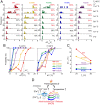Heat-hypersensitive mutants of ryanodine receptor type 1 revealed by microscopic heating
- PMID: 35925888
- PMCID: PMC9371657
- DOI: 10.1073/pnas.2201286119
Heat-hypersensitive mutants of ryanodine receptor type 1 revealed by microscopic heating
Abstract
Thermoregulation is an important aspect of human homeostasis, and high temperatures pose serious stresses for the body. Malignant hyperthermia (MH) is a life-threatening disorder in which body temperature can rise to a lethal level. Here we employ an optically controlled local heat-pulse method to manipulate the temperature in cells with a precision of less than 1 °C and find that the mutants of ryanodine receptor type 1 (RyR1), a key Ca2+ release channel underlying MH, are heat hypersensitive compared with the wild type (WT). We show that the local heat pulses induce an intracellular Ca2+ burst in human embryonic kidney 293 cells overexpressing WT RyR1 and some RyR1 mutants related to MH. Fluorescence Ca2+ imaging using the endoplasmic reticulum-targeted fluorescent probes demonstrates that the Ca2+ burst originates from heat-induced Ca2+ release (HICR) through RyR1-mutant channels because of the channels' heat hypersensitivity. Furthermore, the variation in the heat hypersensitivity of four RyR1 mutants highlights the complexity of MH. HICR likewise occurs in skeletal muscles of MH model mice. We propose that HICR contributes an additional positive feedback to accelerate thermogenesis in patients with MH.
Keywords: calcium channel; heat-sensing; malignant hyperthermia; microheating; skeletal muscle.
Conflict of interest statement
The authors declare no competing interest.
Figures






Similar articles
-
Trans-scale thermal signaling in biological systems.J Biochem. 2023 Jul 31;174(3):217-225. doi: 10.1093/jb/mvad053. J Biochem. 2023. PMID: 37461189 Free PMC article. Review.
-
Ryanodine receptor type 1 (RyR1) possessing malignant hyperthermia mutation R615C exhibits heightened sensitivity to dysregulation by non-coplanar 2,2',3,5',6-pentachlorobiphenyl (PCB 95).Neurotoxicology. 2007 Jul;28(4):770-9. doi: 10.1016/j.neuro.2006.08.007. Epub 2006 Aug 30. Neurotoxicology. 2007. PMID: 17023049 Free PMC article.
-
Functional characterisation of the R2452W ryanodine receptor variant associated with malignant hyperthermia susceptibility.Cell Calcium. 2014 Sep;56(3):195-201. doi: 10.1016/j.ceca.2014.07.004. Epub 2014 Jul 18. Cell Calcium. 2014. PMID: 25086907
-
Advances in malignant hyperthermia: novel insights into heat-induced Ca2+ release as a thermal signaling.J Smooth Muscle Res. 2025;61:65-74. doi: 10.1540/jsmr.61.65. J Smooth Muscle Res. 2025. PMID: 40903240 Review.
-
Elevated resting [Ca(2+)](i) in myotubes expressing malignant hyperthermia RyR1 cDNAs is partially restored by modulation of passive calcium leak from the SR.Am J Physiol Cell Physiol. 2007 May;292(5):C1591-8. doi: 10.1152/ajpcell.00133.2006. Epub 2006 Dec 20. Am J Physiol Cell Physiol. 2007. PMID: 17182726
Cited by
-
Trans-scale thermal signaling in biological systems.J Biochem. 2023 Jul 31;174(3):217-225. doi: 10.1093/jb/mvad053. J Biochem. 2023. PMID: 37461189 Free PMC article. Review.
-
Warm Cells, Hot Mitochondria: Achievements and Problems of Ultralocal Thermometry.Int J Mol Sci. 2023 Nov 29;24(23):16955. doi: 10.3390/ijms242316955. Int J Mol Sci. 2023. PMID: 38069275 Free PMC article. Review.
-
Tunable liquid-solid hybrid thermal metamaterials with a topology transition.Proc Natl Acad Sci U S A. 2023 Jan 17;120(3):e2217068120. doi: 10.1073/pnas.2217068120. Epub 2023 Jan 12. Proc Natl Acad Sci U S A. 2023. PMID: 36634140 Free PMC article.
-
Myosin and tropomyosin-troponin complementarily regulate thermal activation of muscles.J Gen Physiol. 2023 Dec 4;155(12):e202313414. doi: 10.1085/jgp.202313414. Epub 2023 Oct 23. J Gen Physiol. 2023. PMID: 37870863 Free PMC article.
-
Thermal conductivity and conductance of protein in aqueous solution: Effects of geometrical shape.J Comput Chem. 2023 Mar 15;44(7):857-868. doi: 10.1002/jcc.27048. Epub 2022 Dec 5. J Comput Chem. 2023. PMID: 36468822 Free PMC article.
References
-
- Hwang J. H., Zorzato F., Clarke N. F., Treves S., Mapping domains and mutations on the skeletal muscle ryanodine receptor channel. Trends Mol. Med. 18, 644–657 (2012). - PubMed
Publication types
MeSH terms
Substances
LinkOut - more resources
Full Text Sources
Miscellaneous

